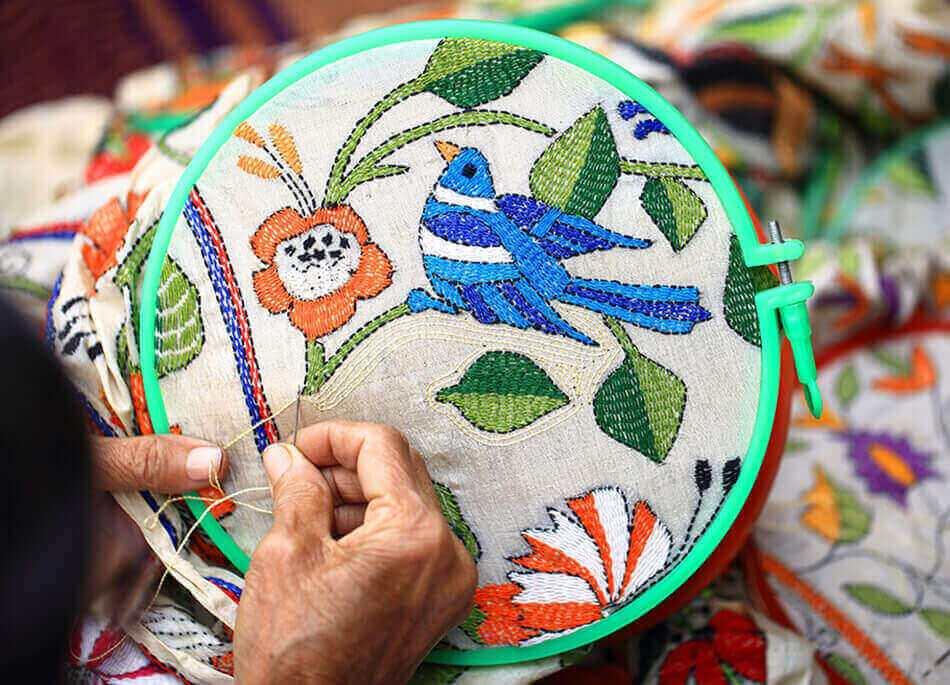A Journey Through the Colorful History of Indian Textiles
Explore the vibrant history of Indian textiles, from ancient craftsmanship to modern innovations. Discover Interestitng background of regional traditions, colonial influences, and contemporary adaptations in this colorful journey through India’s textile heritage.
Ancient Roots: A Journey Through the Colorful History of Indian Textiles
Indian textiles have a lineage that stretches back thousands of years, rooted in ancient traditions and craftsmanship. Archaeological excavations reveal evidence of cotton cultivation and textile production in the Indus Valley Civilization, dating as far back as 5000 years ago. Fabrics found at sites such as Mohenjo-daro depict intricate weaving techniques and the early use of natural dyes.
The Legacy of Indigo – A Journey Through the Colorful History of Indian Textiles
One of the oldest known natural dyes used in Indian textiles is indigo. The history of indigo cultivation and dyeing in India dates back to antiquity. Indigo cultivation was practiced in the southern regions of India, particularly in Tamil Nadu and Andhra Pradesh. The process of extracting and dyeing with indigo was a closely guarded secret among artisans, passed down through generations. This vibrant blue dye became synonymous with Indian textiles and continues to be cherished for its deep hue and lasting color.
Flourishing Traditions: Regional Styles and Techniques – A Journey Through the Colorful History of Indian Textiles
India’s diverse geography and cultural mosaic have given rise to a multitude of regional textile traditions. Each region boasts unique weaving techniques, designs, and motifs that reflect local customs, climates, and lifestyles.
Banarasi Brocade: Weaving Stories of Royalty – A Journey Through the Colorful History of Indian Textiles
In the northern plains of India, Varanasi (Benares) stands as a beacon of exquisite silk weaving known as Banarasi brocade. This centuries-old craft is characterized by its intricate patterns, often featuring floral motifs, paisleys, and geometric designs. Legend has it that Mughal emperors patronized Banarasi weavers, who wove fabrics with gold and silver threads for the royalty. Today, Banarasi sarees and textiles are coveted for their elegance and craftsmanship, making them a timeless symbol of luxury.
Story: Kantha Embroidery – Stitching Tales of Heritage
In eastern India, particularly in West Bengal and Bangladesh, Kantha embroidery tells stories of resilience and creativity. Kantha is a form of embroidery where old sarees and dhotis are repurposed into quilts and covers. Traditionally, women would stitch layers of cloth together using a simple running stitch, often creating intricate designs of birds, animals, and geometric patterns. Each piece of Kantha embroidery carries the personal history and artistic expression of its creator, reflecting the cultural heritage of the region.
Colonial Influence: The Era of Global Trade
The arrival of European traders and colonizers in India had a profound impact on its textile industry. The demand for Indian textiles, renowned for their quality and craftsmanship, surged across Europe and beyond. Textiles such as muslin from Bengal, chintz from Gujarat, and Madras checks from Tamil Nadu became highly sought-after commodities in global markets.
The Rise of Calico – A Journey Through the Colorful History of Indian Textiles
During the 17th and 18th centuries, Indian chintz, or calico, gained immense popularity in Europe. Calico, a plain-woven cotton textile printed with floral designs, captivated European fashionistas and decorators alike. The intricate patterns and vibrant colors of Indian chintz inspired European textile manufacturers to imitate and adapt these designs, leading to the development of the European textile printing industry.
Revival and Renaissance: Preserving Traditional Crafts
In the wake of industrialization and globalization, traditional Indian textile crafts faced challenges from mass-produced fabrics. However, concerted efforts by artisans, designers, and organizations have led to a revival of interest in traditional techniques and sustainable practices.
The Handloom Revival Movement
The handloom sector in India has been a cornerstone of rural economies and cultural heritage. Organizations such as the All India Handicrafts Board and cooperatives like SEWA (Self-Employed Women’s Association) have played pivotal roles in promoting handloom textiles and empowering artisans. Through initiatives focused on skill development, marketing support, and fair trade practices, these efforts have helped sustain livelihoods and preserve the diversity of India’s textile traditions.
Pantheon Parallels: A Cross-Cultural Examination of Powerful Gods | Maya (mayathevoice.com)
How Siddhartha became Gautama Buddha – The Complete Story | Maya (mayathevoice.com)
Contemporary Expressions: Innovations and Adaptations
Today, Indian textiles continue to evolve, blending age-old techniques with contemporary designs and materials. Designers and artisans are experimenting with sustainable practices, natural dyes, and digital technologies to create textiles that resonate with modern sensibilities while honoring ancestral craftsmanship.
Khadi – Fabric of Independence
Khadi holds a special place in India’s textile heritage as a symbol of self-reliance and independence. Mahatma Gandhi promoted khadi as a means to boycott foreign goods during India’s freedom struggle. Khadi is hand-spun and hand-woven from natural fibers, primarily cotton, and is known for its simplicity and durability. Even today, khadi remains a symbol of sustainable fashion and cultural pride, favored by designers and consumers alike for its timeless appeal.
Conclusion: Threads of Tradition, Fabric of Culture
The journey through the history of Indian textiles reveals a tapestry woven with innovation, craftsmanship, and cultural significance. From ancient civilizations to modern times, Indian textiles have embodied the spirit of creativity, community, and resilience. As we look ahead, the preservation and promotion of traditional textile crafts continue to be crucial for sustaining livelihoods, fostering cultural pride, and enriching the global tapestry of fashion and art.
Embark on this journey through India’s textile heritage, and you’ll discover not just fabrics, but stories of tradition, innovation, and the enduring beauty of craftsmanship that transcends time and borders.



